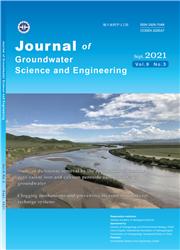流体地球物理学在地下结构和污染物羽流表征中的应用
IF 1.8
4区 地球科学
Q3 WATER RESOURCES
引用次数: 0
摘要
地球物理方法已广泛应用于各种水文地质问题。随着地球物理反演算法和测量工具的不断改进,在地下结构表征、水文地质过程时移监测和污染物羽流圈定等方面取得了重要成果。本文综述了水文地质中应用最广泛的地球物理方法,包括电阻率层析成像(ERT)、感应极化(IP)、探地雷达(GPR)和电磁感应(EMI)。三个例子包括实验室和现场工作,以说明目前应用地球物理方法表征地下结构和污染物羽流。近几十年来,国内外在水地球物理学方面取得了很大的进展,但在实际应用中仍存在挑战。近年来,水文地球物理在水文地球物理模型建立、大尺度结构表征、不确定性分析、生物地球化学过程监测和生态系统科学等领域不断发展。本文章由计算机程序翻译,如有差异,请以英文原文为准。
Applications of hydrogeophysics in characterization of subsurface architecture and contaminant plumes
Geophysical methods have been applied to a wide range of hydrogeological problems. With improvement in geophysical inversion algorithms and measurement tools, significant achievements have been made in the characterization of subsurface architecture, time-lapse monitoring of hydrogeological process and contaminant plumes delineation. In this paper, we summarize the geophysical methods that are most widely used in hydrogeology including Electrical Resistivity Tomography (ERT), Induced Polarization (IP), Ground Penetrating Radar (GPR) and Electromagnetic Induction (EMI). Three examples including lab and field works are used to demonstrate current application of geophysical methods for characterizing subsurface architecture and contaminant plumes. Though great progress has been made in hydrogeohysics over the last few decades at home and abroad, challenges still remain in practical applications. More recently, hydrogeophysics continues to develop in the areas of establishment of hydrogeophysical models, large-scale architecture characterization, uncertainty analysis, biogeochemical process monitoring and ecosystem science.
求助全文
通过发布文献求助,成功后即可免费获取论文全文。
去求助
来源期刊

Journal of Groundwater Science and Engineering
WATER RESOURCES-
CiteScore
2.80
自引率
9.10%
发文量
308
期刊介绍:
It publishes original, innovative, and integrative research in groundwater science and engineering with a focus on hydrogeology, environmental geology, groundwater resources, agriculture and groundwater, groundwater resources and ecology, groundwater and geologic environment, groundwater circulation, groundwater pollution, groundwater exploitation and utilization, hydrogeological standards and methods, groundwater information science, climate change and groundwater. The Editorial Board is composed of more than sixty world-renowned experts and scholars, 47% of whom are foreign scientists. Up to now, the foreign authors contributed papers are from USA, Japan, Canada, Australia, Russia, Mongolia, Thailand and Vietnam.
 求助内容:
求助内容: 应助结果提醒方式:
应助结果提醒方式:


